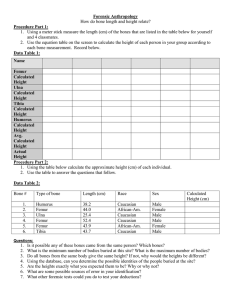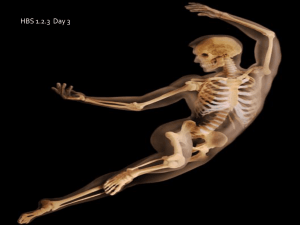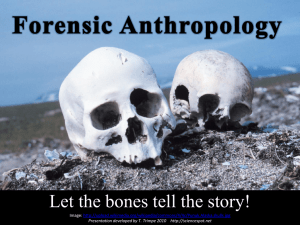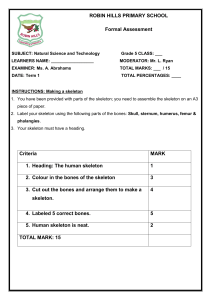Bone Detective Case Report: Forensic Analysis of Skeletal Remains
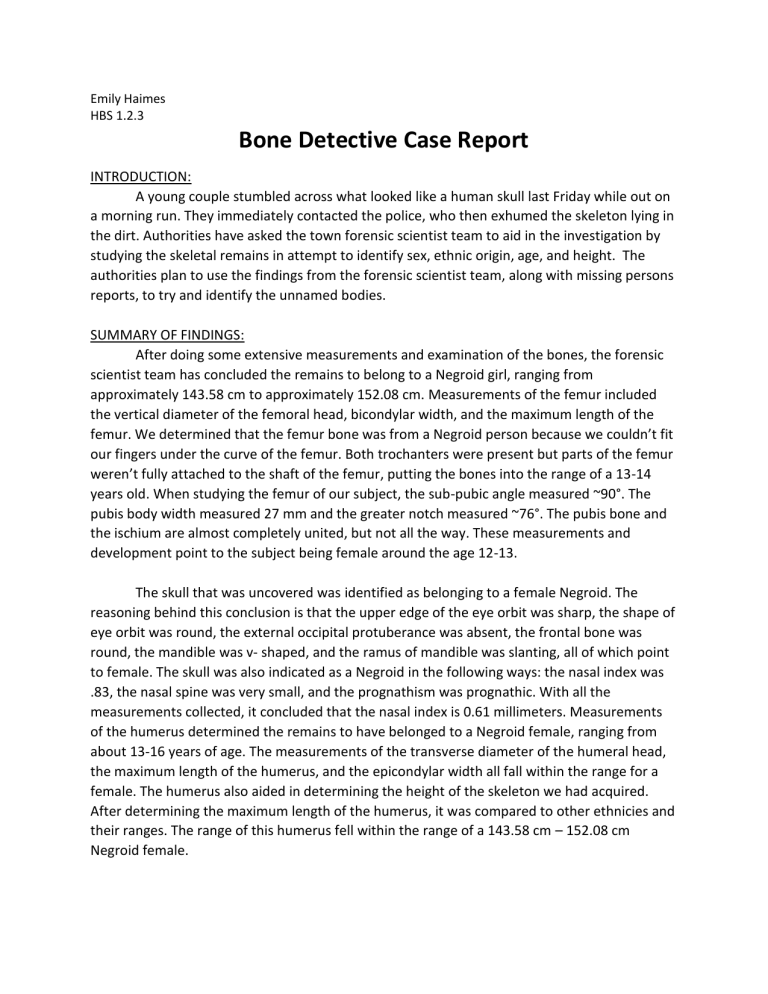
Emily Haimes
HBS 1.2.3
Bone Detective Case Report
INTRODUCTION:
A young couple stumbled across what looked like a human skull last Friday while out on a morning run. They immediately contacted the police, who then exhumed the skeleton lying in the dirt. Authorities have asked the town forensic scientist team to aid in the investigation by studying the skeletal remains in attempt to identify sex, ethnic origin, age, and height. The authorities plan to use the findings from the forensic scientist team, along with missing persons reports, to try and identify the unnamed bodies.
SUMMARY OF FINDINGS:
After doing some extensive measurements and examination of the bones, the forensic scientist team has concluded the remains to belong to a Negroid girl, ranging from approximately 143.58 cm to approximately 152.08 cm. Measurements of the femur included the vertical diameter of the femoral head, bicondylar width, and the maximum length of the femur. We determined that the femur bone was from a Negroid person because we couldn’t fit our fingers under the curve of the femur. Both trochanters were present but parts of the femur weren’t fully attached to the shaft of the femur, putting the bones into the range of a 13-14 years old. When studying the femur of our subject, the sub-pubic angle measured ~90°. The pubis body width measured 27 mm and the greater notch measured ~76°. The pubis bone and the ischium are almost completely united, but not all the way. These measurements and development point to the subject being female around the age 12-13.
The skull that was uncovered was identified as belonging to a female Negroid. The reasoning behind this conclusion is that the upper edge of the eye orbit was sharp, the shape of eye orbit was round, the external occipital protuberance was absent, the frontal bone was round, the mandible was v- shaped, and the ramus of mandible was slanting, all of which point to female. The skull was also indicated as a Negroid in the following ways: the nasal index was
.83, the nasal spine was very small, and the prognathism was prognathic. With all the measurements collected, it concluded that the nasal index is 0.61 millimeters. Measurements of the humerus determined the remains to have belonged to a Negroid female, ranging from about 13-16 years of age. The measurements of the transverse diameter of the humeral head, the maximum length of the humerus, and the epicondylar width all fall within the range for a female. The humerus also aided in determining the height of the skeleton we had acquired.
After determining the maximum length of the humerus, it was compared to other ethnicies and their ranges. The range of this humerus fell within the range of a 143.58 cm – 152.08 cm
Negroid female.
FURTHER ANALYSIS
This technique can be used to create a face shape and appearance for the investigators to put out a claim-call for. The Facial Reconstructionist will use the shape of the skull, along with the predicted race and gender characteristics, to create a model based on tissue thickness on the different parts of the face. Two other tests that can be analyzed using bones are a bone marrow examination and toxicology reports. A BME is conducted by collecting a sample of the fluid that contains cells to examine under a microscope. This examination determines the relationships of bone marrow cells to other cells, and this ratio determines the overall health of individuals. In a toxicology test, bone fragments and bone marrow are often used by coroners to determine whether or not the individual had an addiction or a history with different toxic substances that could have led to their demise. This information can be compared with existing health reports of individuals, or with family accounts of their person, helping with identification.
CONCLUSION:
After full forensic analysis of the skeletal remains, it has been determined that the victim is Negriod, female who was approximately 143.58 cm to approximately 152.08 cm in height. Findings were based on extensive review of the skull, pelvis, femur, and humerus bones in order to confidently eliminate the possibility of the remains being of the male species or of
Mongoloid or Caucasoid ethnic origin. The next step should be to analyze DNA samples from the bones and compare them to samples from all missing victims who match the description of evidence gathered so far. These samples can be compared through gel electrophoresis to determine if any of the missing victims are a positive match to the skeletal remains found. If any of the missing victims are a positive match, then we will locate her family, and solve the mystery of her death.
